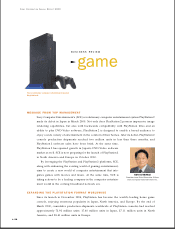Sony 2000 Annual Report Download - page 23
Download and view the complete annual report
Please find page 23 of the 2000 Sony annual report below. You can navigate through the pages in the report by either clicking on the pages listed below, or by using the keyword search tool below to find specific information within the annual report.
SONY CORPORATION ANNUAL REPORT 2000
21
types of MPEG IMX equipment, including VTRs and camcorders for creating next-generation
digital broadcasting systems. In the area of high definition equipment, CSNC received a large
order for Sony’s HDCAM studio production equipment from Mexico’s largest media company,
Televisa Group. Televisa Group will be the first company to implement an HDCAM based studio
in Latin America. Furthermore, regarding digital 24-frame progressive high definition HDCAM
1080/24P production systems, CSNC received an order for ¥1.9 billion of camcorders and re-
lated equipment from Panavision Co., a major U.S. supplier of cameras and other equipment to
the movie and television industries.
Movie director George Lucas an-
nounced plans to use the HDCAM
format video system in the produc-
tion of the next Sta r Wa rs film,
Episode II. By introducing the
HDCAM 24P system, Sony is work-
ing to bring about a new era of digital
electronic cinematography in which
motion picture production shifts from
the previously used film to digital
systems. Separately, in an effort to in-
crease production efficiency, the
manufacture of broadcast-use video
cameras in the U.S. was discontinued
in December 1999 and transferred to
a facility in Europe.
As for new businesses, CSNC
started to offer a digital asset management system which allows broadcasters to preserve digi-
tally large volumes of stored visual content and to search, manage, and distribute such con-
tent. Because demand is high for systems such as this one, which was ordered by the U.S.
broadcaster CNN, not only in the broadcast-use market, but also in the professional-use mar-
ket, CSNC intends to expand such solutions work as one of its core businesses.
In the area of professional-use video equipment, CSNC’s new business-use projector, which
can be carried with ease thanks to its small size and light weight, has received a favorable
reaction from the market and created a new style for mobile presentations. Regarding video
conferencing systems, CSNC’s new smallest class-size high cost performance model has been
very well received.
In July 2000, Sony plans to start offering a corporate broadband Internet service called
“bit-drive” in Japan through a broadband telecommunications infrastructure using WLL (Wireless
Local Loop). This service takes advantage of WLL’s ability to interactively transmit at high-speed
large volumes of data, yielding a network that is extremely flexible. It can provide a total solutions
service to customers by bringing together hardware, services, and content.
Sony cellular phones allow reliable data communications and easy network
connections. Shown above, from right, are three cellular phones that Sony
introduced in Japan: a PDC model compatible with the i-mode service and
two cdmaOne™ models compatible with EZWeb or EZAccess services. Also,
a GSM cellular phone for WAP (Wireless Application Protocol) services was
introduced in Europe.
























